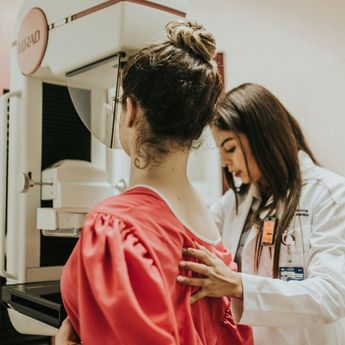By continuing to use our site, you consent to the processing of cookies, user data (location information, type and version of the OS, the type and version of the browser, the type of device and the resolution of its screen, the source of where the user came from, from which site or for what advertisement, language OS and Browser, which pages are opened and to which buttons the user presses, ip-address) for the purpose of site functioning, retargeting and statistical surveys and reviews. If you do not want your data to be processed, please leave the site.
The Voice of People With Breast Cancer
Information
Breast Cancer Basics
High Risk Conditions
Atypical Hyperplasia
Hyperplasia is a non-cancerous (benign) condition where the cells lining the milk ducts and lobules of the breast grow abnormally, resulting in extra cell layers.
Hyperplasia is classified into two types:
- Usual hyperplasia: The cells increase in number but still look relatively normal under a microscope.
- Atypical hyperplasia: The cells grow in an unusual pattern and may appear irregular under a microscope.
Atypical hyperplasia is less common than usual hyperplasia, occurring in about 10% of benign breast biopsies. While it shares some features with breast cancer, it is not cancer. However, it increases the risk of developing breast cancer by 3 to 5 times compared to those without breast changes, making it a precancerous condition.
Risk Factors
The risk factors for atypical hyperplasia are similar to those of breast cancer and include:
- Age (most diagnoses occur after age 50)
- Family history and genetic mutations (e.g., BRCA1, BRCA2)
- Dense breast tissue
- Hormone use (e.g., birth control pills, hormone replacement therapy)
- Lifestyle factors such as alcohol use, physical inactivity, and obesity
- Previous chest radiation exposure
Types of Atypical Hyperplasia
Atypical hyperplasia can occur in two forms:
- Atypical ductal hyperplasia (ADH): Found in the breast ducts, ADH shares some features with ductal carcinoma in-situ (DCIS), but is a benign lesion with an increased risk of future breast cancer.
- Atypical lobular hyperplasia (ALH): Found in the breast lobules, ALH is similar to lobular carcinoma in-situ (LCIS), which increases future breast cancer risk.
An E-cadherin test may be used to help distinguish ADH from ALH, as ADH cells typically produce this protein, while ALH cells do not.
Both ADH and ALH carry similar risks of progressing to breast cancer over time. Research indicates that the absolute risk of developing breast cancer after a diagnosis of atypical hyperplasia is approximately 1% per year or approximately 30% at a 25-year follow-up. The younger a person is at the time of diagnosis, the higher their risk of developing breast cancer later in life.
Diagnosing Atypical Hyperplasia
Atypical hyperplasia typically does not cause noticeable symptoms, although some individuals may experience rare breast pain. It is most often detected during routine breast imaging, such as mammograms or ultrasounds, where it may appear as tiny calcium deposits (microcalcifications).
A breast biopsy is required to confirm atypical hyperplasia. Additional imaging techniques may sometimes be used to help detect abnormalities.
Treating and Managing Atypical Hyperplasia
Treatment options for atypical hyperplasia vary based on factors such as individual risk level and access to specialized care. Common management strategies include:
Close Monitoring
Many individuals are advised to take a "wait and see" approach. This often includes frequent mammograms and possible additional imaging, such as breast MRI or ultrasound, for closer surveillance.
Medications to Lower Breast Cancer Risk
Your healthcare provider may recommend medications to help lower your risk of developing breast cancer. These medications work by reducing estrogen levels or blocking its effects, since estrogen can promote the growth of certain types of breast cancer cells. Common medications include:
- Tamoxifen (for pre and postmenopausal individuals)
- Aromatase inhibitors (for postmenopausal individuals)
- Raloxifene (for postmenopausal individuals)
The effect of these drugs on breast cancer risk has varied across different studies. When the results are combined, these medications reduce the risk of estrogen receptor (ER) - positive breast cancer by approximately 40%. However, they are not effective for preventing ER - negative breast cancer.
If you are taking medications containing estrogen, such as certain birth control pills, your healthcare provider may recommend stopping them to further reduce your risk.
Surgery
In some cases, surgical options may be considered, particularly for individuals with additional high-risk factors. Surgical options include:
- Ultrasound-guided, vacuum-assisted excision: A minimally invasive procedure that removes abnormal breast tissue.
- Lumpectomy: Removal of abnormal tissue along with surrounding healthy tissue.
- Prophylactic Mastectomy: Removal of one or both breasts, typically for individuals with atypical hyperplasia in multiple areas of the breast or those with additional high-risk factors for breast cancer, such as having a family history of breast cancer or having dense breasts.
Medical Review by Roochi Arora, MD, FRCPC, August 2025
- References
-
Alberta Health Services. (2023). Learning about atypical hyperplasia of the breast. https://myhealth.alberta.ca/Health/
aftercareinformation/pages/conditions.aspx?hwid=acf2776American Cancer Society. (2022). Hyperplasia of the breast. Cancer.org. https://www.cancer.org/cancer/types/breast-cancer/non-cancerous-breast-conditions/hyperplasia-of-the-breast-ductal-or-lobular.html
American Cancer Society. (2021). Deciding whether to use medicine to reduce breast cancer risk. Cancer.org. https://www.cancer.org/cancer/types/breast-cancer/risk-and-prevention/deciding-whether-to-use-medicine-to-reduce-breast-cancer-risk.html
American Cancer Society. (2021). Tamoxifen and raloxifene for breast cancer prevention. Cancer.org. https://www.cancer.org/cancer/types/breast-cancer/risk-and-prevention/tamoxifen-and-raloxifene-for-breast-cancer-prevention.html
Breast Cancer Now. (2025). Hyperplasia and atypical hyperplasia. https://breastcancernow.org/about-breast-cancer/breast-lumps-and-benign-not-cancer-breast-conditions/hyperplasia-and-atypical-hyperplasia
Cleveland Clinic. (2023). Atypical ductal hyperplasia. https://my.clevelandclinic.org/health/
diseases/16242-atypical-ductal-hyperplasiaDePolo, J. (2023). Lobular carcinoma in situ (LCIS) and atypical lobular hyperplasia. Breastcancer.org. https://www.breastcancer.org/benign-breast-conditions/lobular-carcinoma-in-situ-atypical-lobular-hyperplasia
Eldridge, L. (2024). Atypical ductal hyperplasia of the breast. Verywell Health. https://www.verywellhealth.com/atypical-ductal-hyperplasia-of-the-breast-430683
Hartmann, L. C., Degnim, A. C., Santen, R. J., Dupont, W. D., & Ghosh, K. (2015). Atypical hyperplasia of the breast - Risk assessment and management options. The New England Journal of Medicine, 372(1), 78–89. https://doi.org/10.1056/NEJMsr1407164
Health Canada. (2006). Product monograph: Apo-raloxifene. https://pdf.hres.ca/dpd_pm/00002184.PDF
Healthline. (2021). Understanding atypical ductal hyperplasia. https://www.healthline.com/health/breast-cancer/atypical-ductal-hyperplasia
Memorial Sloan Kettering Cancer Center. (2019). Atypical hyperplasia. https://www.mskcc.org/cancer-care/patient-education/atypical-hyperplasia
MyPathologyReport.ca. (2023). E-cadherin. https://www.mypathologyreport.ca/pathology-dictionary/e-cadherin/
Susan G. Komen. (2024). Breast cancer risk factors: Hyperplasia and other benign breast conditions. https://www.komen.org/breast-cancer/risk-factor/hyperplasia-and-other-benign-breast-conditions/
Vegunta, S., Mussallem, D. M., Kaur, A. S., Pruthi, S., & Klassen, C. L. (2023). Atypical hyperplasia of the breast: Clinical cases and management strategies. Cleveland Clinic Journal of Medicine, 90(7), 423–431. https://doi.org/10.3949/ccjm.90a.22098
SHARE




